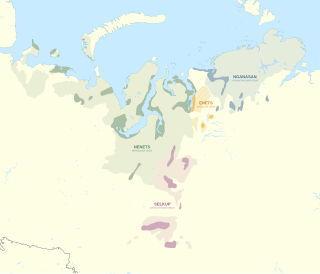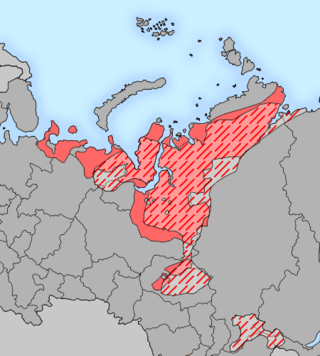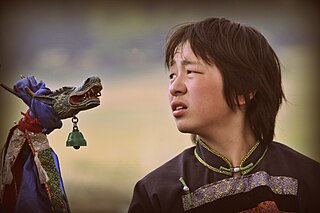Related Research Articles
A pidgin, or pidgin language, is a grammatically simplified means of communication that develops between two or more groups of people that do not have a language in common: typically, its vocabulary and grammar are limited and often drawn from several languages. It is most commonly employed in situations such as trade, or where both groups speak languages different from the language of the country in which they reside. Linguists do not typically consider pidgins as full or complete languages.
Russenorsk is an extinct dual-source "restricted pidgin" language formerly used in the Arctic, which combined elements of Russian and Norwegian. Russenorsk originated from Russian traders and Norwegian fishermen from Tromsø and Kola. It was used extensively in Northern Norway for about 150 years in the Pomor trade. Russenorsk is important as a test case for theories concerning pidgin languages since it was used far away from most of the other documented pidgins of the world.

The Samoyedic or Samoyed languages are spoken around the Ural Mountains, in northernmost Eurasia, by approximately 25,000 people altogether. They derive from a common ancestral language called Proto-Samoyedic, and form a branch of the Uralic languages. Having separated perhaps in the last centuries BC, they are not a diverse group of languages, and are traditionally considered to be an outgroup, branching off first from the other Uralic languages.

The Taymyr Peninsula is a peninsula in the Far North of Russia, in the Siberian Federal District, that forms the northernmost part of the mainland of Eurasia. Administratively it is part of the Krasnoyarsk Krai Federal subject of Russia.

The Nganasans are a Uralic people of the Samoyedic branch native to the Taymyr Peninsula in north Siberia. In the Russian Federation, they are recognized as one of the Indigenous peoples of the Russian North. They reside primarily in the settlements of Ust-Avam, Volochanka, and Novaya in the Taymyrsky Dolgano-Nenetsky District of Krasnoyarsk Krai, with smaller populations residing in the towns of Dudinka and Norilsk as well.
Khariton Prokofievich Laptev (1700–1763) was a Russian naval officer and Arctic explorer.

Boris Andreyevich Vilkitsky was a Russian hydrographer and surveyor. He was the son of Andrey Ippolitovich Vilkitsky.
Fyodor Alekseyevich Minin was a Russian Arctic explorer.

The Samoyedic peoples are a group of closely related peoples who speak Samoyedic languages, which are part of the Uralic family. They are a linguistic, ethnic, and cultural grouping. The name derives from the obsolete term Samoyed used in Russian Empire for some Indigenous people of Siberia, see Samoyedic languages#Etymology for comments of the etymology.
The Nganasan language is a moribund Samoyedic language spoken by the Nganasan people.

In human mitochondrial genetics, Haplogroup C is a human mitochondrial DNA (mtDNA) haplogroup.

A large minority of people in North Asia, particularly in Siberia, follow the religio-cultural practices of shamanism. Some researchers regard Siberia as the heartland of shamanism.
Valek Airport is a small airport in Krasnoyarsk krai, Russia located 9 km northeast of Norilsk along the Valkovskoye highway. The Norilsk river's western bank is where the runway is located. The nearby Valk river, a tributary of the Norilsk river, inspired the airport's name.

A chum is a temporary dwelling used by the nomadic Uralic reindeer herders of northwestern Siberia of Russia. The Evenks, Tungusic peoples, tribes, in Russia, Mongolia and China also use chums. They are also used by the southernmost reindeer herders, of the Todzha region of the Republic of Tyva and their cross-border relatives in northern Mongolia. It has a design similar to a Native American tipi but some versions are less vertical. It is very closely related to the Sami lavvu in construction, but is somewhat larger in size. Some chums can be up to thirty feet in diameter.
Nganasan may refer to:

Biphyllidae, or false skin beetles, are a family of beetles, in the superfamily Cleroidea. They have a cosmopolitan distribution. About 195 species are known. They live under the bark of dead trees and in leaf litter, and are mycophagous, feeding on fungi.
The WCT Arctic Cup is an annual bonspiel, or curling tournament, that takes place in late May at the Taimyr Ice Arena in Dudinka, Russia. The tournament is held in a Round Robin format. The tournament is part of the World Curling Tour. In 2016, the inaugural event was held between Russian men's teams. In 2017 and 2019 it was a women's event, and in 2018 and 2021 it was a mixed doubles event. In 2022, it was held in an open entry format where men's and women's teams competed against each other.

Pre-Finno-Ugric substrate refers to substratum loanwords from unidentified non-Indo-European and non-Uralic languages that are found in various Finno-Ugric languages, most notably Sami. The presence of Pre-Finno-Ugric substrate in Sami languages was demonstrated by Ante Aikio. Janne Saarikivi points out that similar substrate words are present in Finnic languages as well, but in much smaller numbers.
Micromyinae is a subfamily of wood midges, insects in the family Cecidomyiidae. Its members were formerly included in subfamily Lestremiinae. There are at least 55 genera and more than 650 described species in Micromyinae. All species in this subfamily are mycophageous.
Chester S. Chard (1915–2002) was an American anthropologist who collaborated with Russian and Japanese scholars to establish the field of circumpolar or arctic anthropology. He received degrees at Harvard University (1937) and the University of California at Berkeley where he was one of Robert Lowie's last graduate students. He taught for over 20 years, mostly at the University of Wisconsin–Madison, and published over 160 books and articles. His research focused on Old World prehistory, cultural history of North and East Asia, and the interhemispherical relationships of New World cultures and circumpolar problems. He founded the academic journal Arctic Anthropology, in 1962. He published on numerous topics and cultures, including the ball courts of the Southwest, Pre-Columbian trade, the Kamchadal culture, North American burial grounds, the prehistory of Siberia, Inner Asia, prehistoric Japan, the Nganasan people, Eskimos, and the Chukchi Peninsula.
References
- 1 2 Stern, Dieter (2005). "Taimyr Pidgin Russian (Govorka)". Russian Linguistics. 29 (3): 289–318. ISSN 0304-3487 . Retrieved 19 November 2023.